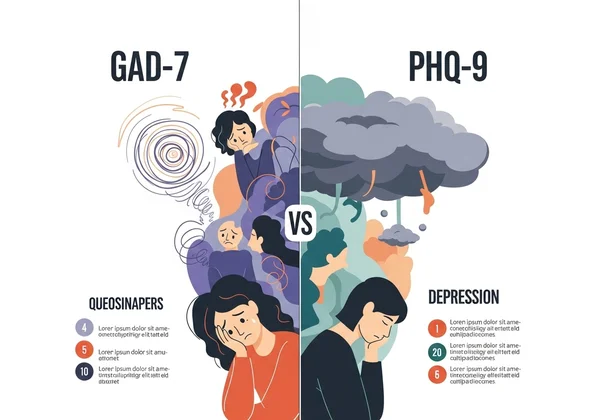GAD-7 vs. PHQ-9: What's the Difference Between These Mental Health Tests?
Trying to understand your mental health can be confusing, especially when feelings of anxiety and depression seem to blend together. You might feel "off," but pinpointing the exact cause is challenging. This is where mental health screeners come in. Two of the most common and trusted tools a professional might use are the GAD-7 and the PHQ-9. But what exactly is the difference between them?
While both are simple questionnaires, they are designed to measure two distinct aspects of your emotional well-being. The GAD-7 screens for anxiety symptoms, while the PHQ-9 screens for depression symptoms. Understanding their unique roles is a crucial first step toward gaining clarity about what you're experiencing.
This guide will break down their differences, explain how the scores are interpreted, and clarify why they are often used together for a complete picture of your mental health.
Key Differences at a Glance
| Feature | GAD-7 (Generalized Anxiety Disorder-7) | PHQ-9 (Patient Health Questionnaire-9) |
|---|---|---|
| Primary Focus | Screens for Anxiety, especially Generalized Anxiety Disorder. | Screens for Depression, especially Major Depressive Disorder. |
| Key Symptoms | Uncontrollable worry, nervousness, restlessness, irritability. | Low mood, loss of interest/pleasure, fatigue, feelings of worthlessness. |
| Number of Questions | 7 questions. | 9 questions. |
| Time Frame | "Over the last 2 weeks." | "Over the last 2 weeks." |
| Scoring Range | 0-21 (Minimal to Severe Anxiety) | 0-27 (Minimal to Severe Depression) |

What is the GAD-7? The Go-To Screener for Anxiety
The GAD-7 (Generalized Anxiety Disorder-7) is a simple yet powerful tool designed to screen for and measure the severity of Generalized Anxiety Disorder (GAD). It focuses on the key mental and physical symptoms of anxiety you may have experienced over the past two weeks. Think of it as a specialized lens that helps bring feelings of worry, nervousness, and tension into focus.
This assessment is not just a random checklist; it's a scientifically validated questionnaire used globally by healthcare providers. Its purpose is to provide a reliable snapshot of your anxiety levels, helping you and your doctor understand the extent to which anxiety might be impacting your daily life. It is an excellent starting point for a more informed conversation about your mental health.
Purpose and Focus of the GAD-7
The GAD-7 scale consists of seven questions, each targeting a core symptom of generalized anxiety. Developed by Drs. Robert L. Spitzer, Kurt Kroenke, and colleagues, this tool asks you to reflect on how often you have been bothered by issues like feeling nervous, being unable to stop worrying, or becoming easily irritable. Its primary purpose is to act as a preliminary screening instrument.
It’s essential to remember that the GAD-7 is a screener, not a diagnostic tool. A high score doesn't automatically mean you have GAD, but it strongly suggests that you could benefit from a conversation with a healthcare professional. It provides an objective score that can be used to track symptoms over time, making it a vital part of managing anxiety effectively. You can take the confidential GAD-7 test on our site to get a clearer picture.

GAD-7 Scoring Interpretation: What Your Score Means
Understanding your GAD-7 scoring interpretation is straightforward. After answering the seven questions, your responses are scored from 0 ("not at all") to 3 ("nearly every day"), and the total is added up. The final GAD-7 score ranges from 0 to 21.
Here is a general breakdown of what the scores typically indicate:
- 0-4: Minimal anxiety. Your anxiety levels are likely within a normal range.
- 5-9: Mild anxiety. You may be experiencing some symptoms that cause mild distress.
- 10-14: Moderate anxiety. Your symptoms are likely causing noticeable impairment in your daily life, and further evaluation is recommended.
- 15-21: Severe anxiety. Your symptoms are causing significant distress and impairment, making a professional consultation highly advisable.
Receiving a score in the moderate to severe range is a sign that it’s time to seek support. Our platform not only gives you an instant score but also offers an optional AI-powered report to provide deeper insights into your anxiety score.
What is the PHQ-9? The Standard Screener for Depression
Just as the GAD-7 is tailored for anxiety, the Patient Health Questionnaire-9 (PHQ-9) is the go-to screening tool for depressive symptoms. This questionnaire is designed to identify the presence and severity of depression. It helps quantify feelings that can be difficult to describe, such as persistent sadness, loss of interest, and changes in sleep or appetite.
The PHQ-9 is also a widely respected and validated tool used in clinical settings. It serves a similar function to the GAD-7: providing a clear, measurable overview of symptoms to facilitate a productive discussion with a doctor or mental health professional. It helps translate vague feelings of being "down" into actionable data.
Purpose and Focus of the PHQ-9
The PHQ-9 depression test is composed of nine questions that align with the diagnostic criteria for major depressive disorder in the DSM-5 (the standard classification of mental disorders). The questions probe into core depressive symptoms experienced over the last two weeks, including low mood, anhedonia (the inability to feel pleasure), feelings of guilt or worthlessness, and thoughts of self-harm.
Its specific focus on these indicators is what makes it so effective for screening for depression. By isolating these symptoms, it helps differentiate the deep-seated sadness and lack of motivation characteristic of depression from the worry and fear that define anxiety.

Interpreting Your PHQ-9 Score: Ranges and Implications
Similar to the GAD-7, the PHQ-9 is scored by tallying the points from each of the nine questions, resulting in a total score between 0 and 27. The interpretation provides a clear indication of depression severity.
The typical score ranges are:
- 0-4: Minimal depression.
- 5-9: Mild depression.
- 10-14: Moderate depression.
- 15-19: Moderately severe depression.
- 20-27: Severe depression.
A score of 10 or higher is often used as a clinical cut-off point, signaling a need for further assessment for a depressive disorder. Any positive response to the final question about self-harm requires immediate follow-up with a professional.
Comparing GAD-7 and PHQ-9: The Core Differences
Now that we understand each tool individually, comparing them directly highlights their distinct roles. The primary difference lies in their symptom focus: one is built for anxiety, the other for depression. While their questions may seem similar, they are carefully crafted to capture different emotional and physical experiences.
Symptom Focus: Anxiety vs. Depression
The GAD-7 and PHQ-9 measure different sets of symptoms that are central to anxiety and depression, respectively.
-
GAD-7 (Anxiety) primarily asks about:
- Feeling nervous, anxious, or on edge
- Uncontrollable worrying
- Worrying too much about different things
- Trouble relaxing
- Restlessness
- Becoming easily annoyed or irritable
- Feeling afraid as if something awful might happen
-
PHQ-9 (Depression) primarily asks about:
- Little interest or pleasure in doing things (anhedonia)
- Feeling down, depressed, or hopeless
- Trouble with sleep (too much or too little)
- Feeling tired or having little energy
- Changes in appetite or weight
- Feeling bad about yourself (guilt, worthlessness)
- Trouble concentrating
- Moving or speaking slowly, or being fidgety
Essentially, the GAD-7 centers on themes of fear and worry, while the PHQ-9 revolves around themes of mood and loss of interest.
Why Are These Mental Health Screeners Often Used Together?
Anxiety and depression have a high rate of comorbidity, meaning they frequently occur at the same time. A person with an anxiety disorder is very likely to also experience symptoms of depression, and vice versa. This clinical overlap can make self-assessment confusing. Are you irritable because you're worried, or because you're feeling hopeless?

Healthcare providers use both the GAD-7 and PHQ-9 together to detangle these symptoms. Administering both screeners provides a more complete clinical picture, ensuring that a co-occurring condition isn't missed. This allows for a more accurate and holistic treatment plan that addresses all of a patient's needs.
Beyond GAD-7 and PHQ-9: Other Mental Health Screeners
While the GAD-7 and PHQ-9 are the most common screeners for anxiety and depression, it's helpful to know they are part of a larger family of tools. Other questionnaires doctors may use include the Kessler Psychological Distress Scale (K10) to measure general psychological distress or the Mood Disorder Questionnaire (MDQ) to screen for bipolar disorder. Each tool is designed with a specific purpose, helping to build a comprehensive understanding of an individual's mental health.
Making Sense of Your Scores: What to Do Next
Distinguishing between the GAD-7 and the PHQ-9 empowers you to take a more active role in your mental health journey. The GAD-7 is your specialized tool for measuring anxiety symptoms, while the PHQ-9 focuses on depression. Knowing what each tool measures is the first step toward gaining clarity and seeking the right kind of support.
If you've been feeling overwhelmed by worry or nervousness, the GAD-7 is an excellent place to start. It provides a quick, confidential, and scientifically-backed way to understand your symptoms. This knowledge can be the catalyst for a meaningful conversation with a loved one or a healthcare professional. Don't let uncertainty hold you back. Take the free GAD-7 assessment today to take your first step toward understanding and managing your anxiety.
Frequently Asked Questions About GAD-7 and PHQ-9
Can the GAD-7 diagnose anxiety?
No, the GAD-7 is a highly effective screening tool, but it is not a diagnosis. A formal diagnosis of an anxiety disorder can only be made by a qualified healthcare professional after a comprehensive evaluation. The GAD-7 score is a valuable piece of information to bring to that appointment.
How accurate is the GAD-7 test?
The GAD-7 is considered a reliable and valid tool for screening for Generalized Anxiety Disorder. Numerous studies, such as the original validation study published in the Archives of Internal Medicine, have demonstrated its accuracy in identifying individuals who may have GAD, making it a trusted instrument in clinical practice.
Is GAD-7 or PHQ-9 better?
Neither test is "better"; they simply measure different things. The GAD-7 is best for assessing anxiety symptoms, while the PHQ-9 is best for assessing depression symptoms. The "right" tool depends entirely on the symptoms you want to screen for. Often, they are used together for a more complete picture.
What does my GAD-7 score mean if I also feel depressed?
This is a common experience due to the high overlap between anxiety and depression. Your GAD-7 score specifically reflects the severity of your anxiety symptoms. If you also feel depressed, you would likely score on the PHQ-9 as well. It's important to discuss both sets of feelings with a doctor to get a full picture.
Can I take both the GAD-7 and PHQ-9 tests online?
Yes, both tests are widely available online. However, it's crucial to use a reputable source. gad-7.org provides a secure, confidential, and user-friendly platform specifically for the GAD-7, including an optional AI-driven report for deeper insights. You can start your GAD-7 test here.
What should I do with my GAD-7 or PHQ-9 score?
If your score on either test is in the moderate to severe range, or if you are concerned about your mental health regardless of the score, the most important next step is to schedule an appointment with a doctor or mental health professional. These scores are a starting point for a conversation, not an endpoint.